New Method Allows Researchers to Observe Molecules Moving Inside Living Cells


The STED-RICS microscope scans the fluorescent cell membrane with a light spot and, thus, an image is recorded. (Figure: P. N. Hedde/KIT)
Researchers at Karlsruhe Institute of Technology have combined two different methods to develop a technique for visualizing and recording movement of molecules in live samples. The new technique is a combination of Stimulated Emission Depletion Microscopy (STED Microscopy) and Raster Image Correlation Spectroscopy (RICS).
STED fluorescence microscopy is used to pursue the movement and interactions of biomolecules in live samples at high spatial and temporal resolution by marking the structures selectively with fluorescent dyes. But the major drawback of this standalone method is that the rapid molecule movements can’t be recorded directly. The solution lies in this new STED-RICS method which makes measurement of those rapid molecule movements possible.
In the STED-RICS method, the fluorescence images are recorded point by point at fixed intervals by reducing the light spot while scanning the regions with very high protein concentrations. The implicit time structure in the images is used by RICS to determine the movement of molecules inside living cells and tissue samples. This method has a lot of potential applications in life sciences research. It will be instrumental in understanding the dynamics of cell membrane, protein-ligand docking and cell signalling pathways. STED-RICS method will also be useful in drug discovery and pharmacodynamic studies.
More information about STED-RICS method is available on Nature Communications.
Source: KIT

